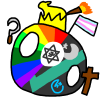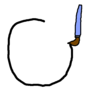 |
Self Insert "People can really believe anything these days!" - Ismism This page is meant to represent Goreo's political views. Please do not make any major edits without their permission. |
 |
Work in Progress "I'll be done any day now!" - Still-Being-Drawnism This page is not done yet and may still contain inaccurate information or miss important details. |
Saxon National Revivalism is the self-insert of ![]() Goreo. The ideology advocates for the independence of a Low-Saxon state.
Goreo. The ideology advocates for the independence of a Low-Saxon state.
Disclaimer
From this point onwards, you will find the terms Saxon and Low-Saxon used interchangeably. This is because followers of this ideology do not recognize the claim of the German state of Saxony to the name Saxony, instead wishing for it to be returned to the homelands of the Saxons. These are heavily disputed, some saying they went from Amsterdam to the Oder, others saying they only existed in Hamburg and surrounding coast. For the sake of consistency, this ideology assumes the borders of the duchy of Saxony as the homelands.
Beliefs
Government
Democracy
Saxon National Revivalism believes in a form of Cellular Democracy, in which each 1st-Level Cell would contain not just elected representatives, but also worker's representatives. These could come in the form of union representatives, collective leaders, or any other form of worker's representative. These worker's representatives would make up around 20-25% of the cellular parliament. If a 1st-Level Cell is unable to gather enough worker's representatives to reach the 20% mark, it will be merged with another neighboring 1st-Level Cell.
A semi-direct democracy is to be established. Issues in the lower cells are to be directly voted on in most cases. Issues in the higher cells have to be approved by more than 50% of their child cells, which again represent their child cells via the elected representatives.
Culture
Economy
Definitions
Cellular Democracy
Cellular Democracy is a form of governance, in which power is decentralized radically into many subdivisions, which again decentralize their power into more subdivisions and so forth. Since Cellular Democracy is a pretty undefined set of beliefs, this page will use some new terminology to describe certain things, which will be explained below.
General
- Cell = A government in a cellular democracy of any level in the hierarchy.
- Child Cell = A subordinate cell to another parent cell.
- Parent Cell = A cell which manages a child cell.
Levels
- 1st-Level Cell = The lowest level in the hierarchy, these ones would usually govern about 1.000 people.
- 2nd-Level Cell = A 2nd-Level Cell stands higher than a 1st-Level Cell and would usually contain about 10 1st-Level Cells.
- 3rd-Level Cell = A 3rd-Level Cell governs the 2nd-Level Cells. In a city below 150K people, it is the city government, managing all 2nd-Level cells in the city. If the city has over 150K people though, then it becomes just another subdivision. In the case of a city having more than 150K people, a 3rd-Level Cell will contain about 10 2nd-Level Cells.
- Supercell = A Supercell is reserved for cities with a higher population than 150K people, as cities below that number already have a city cell. It will manage all the 3rd-Level Cells within that city.
- 4th-Level Cell = The 4th-Level cells will divide up the country, with each based on their closest Supercell. Each 4th-Level Cell can only contain a single Supercell, from which it will expand it's governance over other 3rd-Level Cells, until it meets another 4th-Level Cell.
- National Cell = The national cell is the cell which contains the national government, it manages all 4th-Level Cells below it, and is the only cell capable of amending or changing the constitution in any way.
Gallery
References on this Page
How to Draw

- Create a white background
- Divide it diagonally and fill the bottom-right half with red.
- Draw a red shield with a Nesselblatt.
| Color Name | HEX | RGB | |
|---|---|---|---|
| Red | #EF0019 | 239, 0, 25 | |
| White | #FFFFFF | 255, 255, 255 | |
